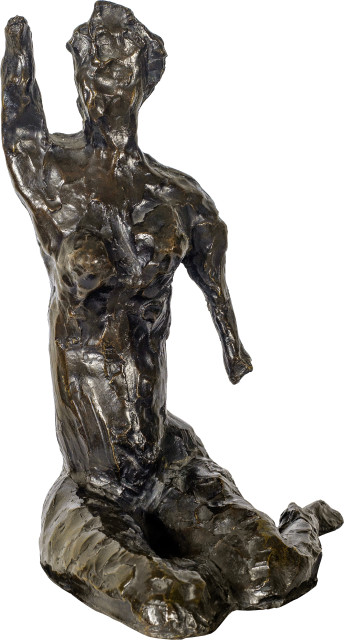- FR
S’inscrire
- Acheter
- Vendre
- Plus
- Galerie
- Commerce d'art
- Maison d'Édition
- Kornfeld aujourd’hui
- L'histoire de la Maison
- Informations



Cateau 1869 - 1954 Nizza
1949, cast 1958
Bronze
25,5x16x16,5 cm
With the monogram "HM", below it with the number "4/10". With the founder's stamp "C. Valsuani, cire perdue"
Claude Duthuit/Wanda de Guébriant, Henri Matisse, Catalogue raisonné de l'œuvre sculpté, Paris 1997, no. 81
Col. Theodor Ahrenberg, Stockholm
Auction Sotheby's, London, 7.7.1960, Cat. No. 20
ECR Henry M. Roland, London, 1960
Auction Sotheby's, London, 1.4.1987, Cat. No. 124; acquired there by
International Private Collection
Perfect casting with strong, brown patina
At the beginning of the 1930s Matisse lost interest in sculptural works. It was not until 1949-1950/1951 that he created four more works, a crucifix and three "nudes". The nudes are clearly inspired by the achievements of sculpture after the Second World War, the design seems very reduced, and the surface treatment much freer than in the early sculptures. The bronze offered here is very dynamic, despite the sitting pose. An expressive work from the sculptural late work of the artist
1949, Guss 1958
Bronze
25,5x16x16,5 cm
Mit dem Monogramm "HM", darunter mit der Nummer "4/10". Mit der Giesserstempel "C. Valsuani, cire perdue"
Claude Duthuit/Wanda de Guébriant, Henri Matisse, Catalogue raisonné de l'œuvre sculpté, Paris 1997,
Slg. Theodor Ahrenberg, Stockholm
Auktion Sotheby’s, London, 7.7.1960,
Slg. Henry M. Roland, London, 1960
Auktion Sotheby’s, London, 1.4.1987,
Internationale Privatsammlung
Tadelloser Guss mit kräftiger, brauner Patina
Zu Beginn der 1930er Jahre verlor Matisse das Interesse an plastischen Arbeiten. Erst von 1949-1950/1951 entstanden noch einmal vier Werke, ein Kruzifix und drei "Akte". Die Akte sind klar inspiriert von den Errungenschaften der Bildhauerkunst nach dem Zweiten Weltkrieg, die Gestaltung wirkt sehr reduziert, und die Oberflächenbehandlung viel freier, als bei den frühen Plastiken. Die hier angebotene Bronze ist sehr dynamisch, trotz sitzender Pose. Eine expressive Arbeit aus dem plastischen Spätwerk des Künstlers




